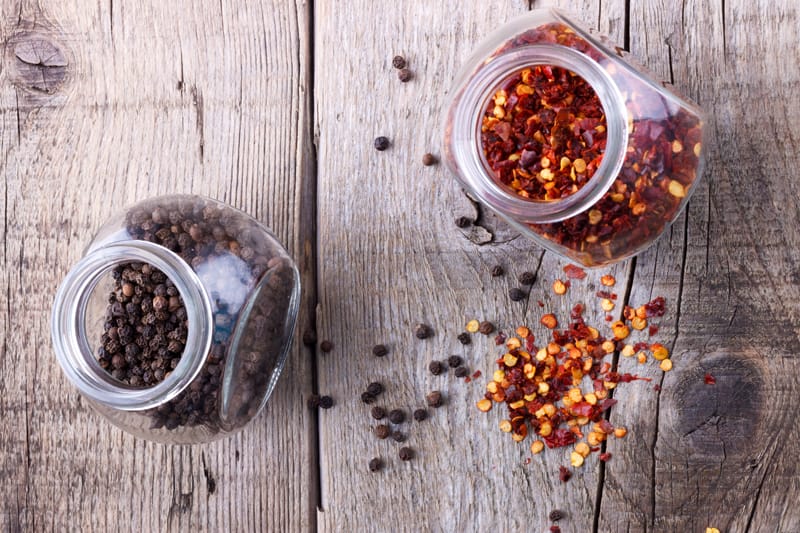“Let food be thy medicine and medicine be thy food.” -Hippocrates, “the father of Western medicine”
The magical things spice does for our bodies
Spices play an important role in a dish. Spices enhance the flavor of a dish, though they have the capacity to do much more than taste good. Indian cuisine has a variety of the healthiest traditional spices. Some spices are used year-round, though may or not be particularly beneficial during a particular season. During the colder months, red pepper, black pepper, cumin and garlic make a seasonal spice medley to boost health and stay balanced.
Red pepper for digestion and weight management
If you want to add more flavor to your food plus health benefits like weight loss and pain relief, try adding crushed red pepper to your meals. Both in Ayurveda and traditional Chinese medicine, red peppers have been used to treat digestive problems, circulatory problems, infections and arthritis.
How it works? Polyphenols are antioxidants found in crushed red pepper that give them a strong disease-preventing property. The antioxidants in red pepper strengthened the immune system’s ability to reduce oxidative stress and prevent from diseases such as cancer, swelling, heart disease and increased immune function. In addition, capsaicin in hot peppers promotes circulation, which may prevent hardening of arteries and reduce risk of heart attack and stroke.
Red pepper flakes are great alternative to salt. If you’re watching your salt intake, red pepper flakes can be an excellent alternative. They’ll add the much-needed flavor without packing on the sodium.
Mineral-rich black pepper for digestion, immunity and metabolism
Black Pepper is one of the most common spices used in cuisines around the world. Millions of people who consume black pepper every day might not be aware of the fact that it is classified as a medicinal spice and is very rich in mineral content. Black pepper is a hot, pungent spice. It has an active component called piperine that gives black pepper its characteristic taste. In fact, it is used extensively in Ayurvedic medicine. It also contains iron, potassium, calcium, magnesium, manganese, zinc, chromium, including vitamins A and C.
An essential volatile oil. Black pepper usually is added to dishes when they are done cooking, otherwise its volatile oils tend to evaporate and diminish its flavor. Freshly ground black pepper has the most flavor. It is main ingredients to prepare various sauces. Black pepper aids digestion and also helps in relieving cough and common cold. It also has an antibiotic property. Apart from these uses, black pepper contains helpful chemicals that support the body in managing gastrointestinal disease, bacterial infection, cold and cough, flu and congestion, free radical suspension, metabolism, skin treatment, dental health, antidepressant, carminative, anti arthritic, diuretics and regulate blood pressure.

Cumin for weight management, digestion and acne
Cumin, a tiny seed coming from a plant of the Apiaceae family, is native to the Mediterranean. Many people are often confused between cumin seeds and caraway seeds because they look the same in appearance: long and brownish in color. Cumin seeds can be discerned by their lighter color, hotter taste and larger size.
Trying to lose weight? Jeera, or cumin seed is an essential Indian spice for most cooking. Originally, we added this spice to our dish not only for its wonderful flavor and aroma, but also for the number of health benefits it has. It may surprise you, but a pinch of cumin powder or seeds can lead to a major improvements in weight loss. New research shows that cumin powder can help jumpstart weight loss, decrease body fat, and improve unhealthy cholesterol levels naturally.
Why cumin seeds in diet are so important? The presence of thymol and other essential oils in cumin seeds stimulate the salivary glands, thereby helping in the digestion of food. Apart from this, they strengthen a sluggish digestive system. Cumin seed also manages and prevents acne. When toxic substances accumulated in your body, your skin will become more vulnerable to breakouts. One of the recommended Ayurvedic preventions for acnes is including cumin in your food. The possible reason may be that cumin contains active components such as Thymol, Cuminaldehyde, and phosphorous, which have detoxifying properties; hence, eating cumin regularly will help to remove the toxins from your body.

The myriad benefits of garlic
While garlic is a common ingredient in every kitchen, in ancient times, it was highly valued for its numerous health benefiting properties, which are still followed in many cultures today. Our ancestors have used it as a bug-repellant, Medieval Europe against the plague and the Egyptians would even bury it along with their dead!
Traditionally called stinking rose or rocambole, garlic is more than just a spicy, pungent addition to food. It was used as long ago as ancient Egyptian times as a traditional remedy to maintain health and treat disease. Other uses include treatment of fever, coughs, headache, stomach ache, sinus congestion, gout, joint pain, hemorrhoids, asthma, bronchitis, shortness of breath, low blood sugar, snakebites, diarrhea and bloody diarrhea, tuberculosis, bloody urine, a serious nose and throat infection called diphtheria, whooping cough, tooth sensitivity, stomach inflammation (gastritis), scalp ringworm, and a sexually transmitted disease called vaginal trichomoniasis. It is also used for fighting stress and fatigue.
How does it work? Garlic produces a chemical called allicin, a sulfur compound similar to that found in onions which is cited as the active agent for many health conditions. Allicin also produces the well-known garlic odor. Some products are made “odorless” by aging the garlic, but this process can also make the garlic less effective. It’s a good idea to look for supplements that are coated (enteric coating) so they will dissolve in the intestine and not in the stomach. The allicin in garlic can help with hair loss and its anti-inflammatory property can help with psoriasis. Our red blood cells can take some types of sulfur-containing molecules in garlic and use them to produce H2S. This H2S in turn can help our blood vessels expand and keep our blood pressure in check. Interestingly, some processed garlic extracts cannot be used by our red blood cells in the same way and do not seem to provide the same level of cardio protection that is provided by garlic in food form.





